Abstract
The cave system in the Sierra de Atapuerca holds one of the most important archaeological sites for the understanding of early human occupation in Europe. Among the different cavities and galleries, the Gran Dolina cave yielded a new hominin species coined as Homo antecessor of an Early Pleistocene age. Encouraged by our previous results in Gran Dolina, we carried out a study to extend and deepen our rockmagnetic investigation of the paleoenvironmental reconstruction of the upper Gran Dolina cave based on experiments that include composition, relative concentration, and grain size of the magnetic iron oxides present in the sediments. Based on the rockmagnetic experiments, we identified magnetite, hematite, goethite, and possibly maghemite in changeable amounts along the profile, which allows us to complement the existing shortage in the literature on the palaeoenvironmental reconstruction of the site. We tentatively interpret the rockmagnetic changes recorded in the cave sediments in terms of glacial/interglacial conditions, furnishing the base for a better understanding for the formation conditions of this unprecedented archaeological site.
1. Introduction
Environmental processes and climatic conditions can be extracted from magnetic minerals that are present in sediments ([1,2,3] and reference therein). With the available modern magnetic instruments, it is possible to detect the presence of trace minerals throughout their magnetic properties, using the dependence to magnetic fields (coercivity) and temperature (Curie point). The key in such paleoclimatic and paleoenvironmental reconstructions is based on three main aspects: composition, concentration, and granulometry of the magnetic minerals.
Caves provide ideal environments for sediment deposition as well as for human activity to furnish protection. Added to UNESCO’s World Heritage List in 2000, the caves of the Sierra de Atapuerca site provide unique testimony of the presence and evolution of the earliest hominids in Europe. The so-called Atapuerca archaeological site includes, among others, the Trinchera del Ferrocarril (Railway Trench), which provides a sign of continuous human occupation from the Early and Middle Pleistocene.
Previous studies based on palynomorphs and faunal remains from the Sierra de Atapuerca caves have attempted to decipher the climatic conditions that were favourable to human presence [4,5,6], but there is still a lot of uncertainty.
For this reason, we carried out a first environmental reconstruction of the upper sedimentary succession of Gran Dolina cave [7] based on the magnetic properties of the sediments. Therefore, encouraged by our initial results, we extended the study to the uppermost stratigraphic units in Gran Dolina using a similar approach. In this paper, after a description of the regional setting and the basics of the archaeological site, we describe the magnetic parameters that we use in order to characterize the composition, concentration, and grain size of the magnetic minerals present in the cave sediments and then finally present a coherent interpretation of the environmental conditions and possible correlation to the Marine Isotope Stage (MIS).
2. Regional Setting and Archaeological Sequence
The Sierra de Atapuerca is a gentle mountain range located in the north-central Iberian Peninsula, within the Duero Basin and between the Ubierna and Demanda mountains, to the north and south, respectively. From a geological point of view, it is a NNW-SSE overturned anticlinal ridge mostly made of Late Cretaceous carbonates. During the Quaternary, and in response to the evolution of the local phreatic condition, a multi-level endokarst system developed in these Cretaceous limestones [8]. The archaeological sites of the “Trinchera del Ferrocarril” (railroad trench) were exposed during the construction of a railway trench running southeast to northwest through the Atapuerca Mountain Range at the beginning of the 20th century. Our study is centred in the Gran Dolina cave (Figure 1), which contains one of the most complete Quaternary stratigraphic sequences with human fossils in Spain. The sedimentary infill is 19 m thick and has traditionally been divided in 11 lithostratigraphic units, TD1–TD11 from the base to the top [9,10]. The formation of the karst and the sedimentary infill respond to the progressive incision of the main river, Arlanzón, starting at least around 1.4 Ma [11]. Shortly after the Jaramillo Subchron (1.07–0.99 Ma), the sedimentary input in the cave is mostly due to gravitational-alluvial sediments [12,13,14,15]. The TD10.1 unit represents the last use of the cave as a central campsite before its final collapse [16].
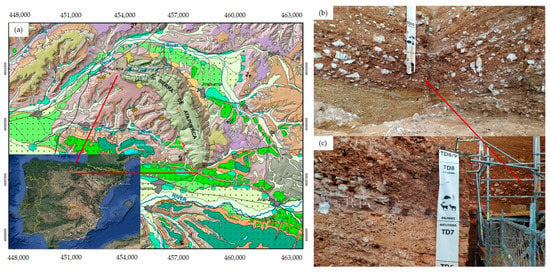
Figure 1.
Location of the archaeological site in the Sierra de Atapuerca. (a) Geomorphological map of the Sierra de Atapuerca, also respective to location in Spain. (b) Inner corner of the highest units of this cave, from which we have taken samples of TD9–TD10 units. (c) Front view of the studied profile analysed, from units TD6 to TD8.9. The photographs (b,c) were taken in summer 2021.
The chronology of the sedimentary infill is due to paleomagnetism, ESR, U-series, and OSL ([17,18,19,20] and references therein). For this study, it is important to highlight the presence of the Matuyama–Brunhes boundary in the upper part of the TD7 unit, and hence, the Lower–Upper Pleistocene limit. Therefore, units TD1 to TD7 belong to the Lower Pleistocene, whereas TD8 to TD11 belong to the Middle Pleistocene. In this paper, we will focus on the entrance facies of the cave—in particular, the interval between the upper part of TD6 and TD10 units. TD6, the oldest stratigraphic unit with hominid fossils in Gran Dolina [21], was deposited during a warm-temperate period, as revealed by the amphibian and squamate reptile assemblages [22,23,24,25]. The passage to the overlying unit TD7 represents an abrupt climatic change as evidenced in our previous study [7]. TD8 is characterized by at least four units that overall show a decrease in grain size [13]. From an environmental point of view, the presence of thermophilous amphibian and squamates indicates relatively humid-temperate conditions and open environment with permanent water streams. A transition from dry open woodlands to a more open and humid environment has been suggested in the TD8.9 unit [26]. The TD9 unit is described as a phosphatic layer, sterile and composed of bat guano [13]. It has a lenticular shape with its maximum thickness of around one meter to the SE. TD10 unit is the last occupation level from Gran Dolina, dated as Marine Isotope Stage (MIS) 11–9 from geochronological studies [17,27,28,29]. This unit is composed of four subunits (TD10.4 to TD10.1, from base to top) dated between 450 ka and 250 ka [27,28,29] where we find a succession of strata, 3 m thick, associated with breccias and fluvial facies. An environmental change has been detected within TD10 unit [30,31], from the relatively closed-in cavity of TD10.4 to open cave of TD10.1, where we have high density of lithic and faunal remains with little evidences of secondary access and modification by carnivores. Another characteristic of this unit is the presence of two bison bone beds: one in the lowest unit and another in the middle of TD10.2. This latter represents a layer with at least 60 individuals in which no significant post-depositional processes have occurred, and the low-taxonomic diversity excluded important changes in terms of paleoclimate in this sequence [31].
3. Material and Methods
We collected 195 samples along a vertical profile in the Gran Dolina cave in plastic bags using non-magnetic instruments. Due to the current state of the archaeological site, we logged and sampled two complementary different profiles: one comprising units TD6–TD8.9 and another about 5 m to the SE for the units TD9–TD10 (as shown in Figure 1b,c). Our rockmagnetic study was carried out in both the Archaeomagnetism Laboratory at the CENIEH (Burgos, Spain) and Paleomagnetism Laboratory at the University Complutense of Madrid (UCM). The following measurements were performed at CENIEH: susceptibility at two frequencies, isothermal and anhysteretic remanent magnetization, and hysteresis loops. The thermomagnetic study was carried out at UCM.
The bulk susceptibility was measured with an Agico MFK1-FA instrument, obtaining in addition the phase angle—a parameter influenced by all the mineral fractions present in the samples [32] and defined as the difference between in-phase and out-of-phase susceptibility [33,34]. The same instrument was used to measure the susceptibility at two different frequencies, and , 976 and 15.616 Hz, respectively. We then normalized the frequency-dependent susceptibility (as suggested by [35]) as follows:
where —as introduced by [36]— and are the high and low frequencies, respectively.
We measured the hysteresis cycles with a MicroMag 3900 VSM (Vibrating Sample Magnetometer, LakeShore instrument, MIT Lincoln Laboratory, Cambridge, MA, USA), which is capable of reaching a maximum field of 1.3 Tesla, although we use 0.5 T. The samples used for this instrument were prepared in small gel capsules of ~0.10 mL volume.
Remanence (IRM, ARM) was measured with a three-axes SQUID cryogenic magnetometer (SRM, 2G Enterprises, Applied Physics Systems, Silicon Valley, CA, USA).
Additional progressive IRM acquisition curves up to 5 T were obtained by an impulse magnetizer (ASC Scientific, Model IM10-30, Narragansett, RI, USA), which were used to infer the magnetic components present through their magnetic coercivity.
In order to determine the relative concentration of low to high coercivity minerals, we carried out a particular study based on the application of a saturation magnetization (SIRM) of 5 T, with the help of the impulse magnetizer, followed by alternating field demagnetization at 100 mT to remove the contribution of any ferrimagnetic minerals (e.g., magnetite). Next, we set thermal demagnetization at 130 °C to remove the goethite contribution (method described by [37]).
The grain size and mineralogical composition are inferred from several ratios: the parameter S-ratio provides a measure of the relative amount of high-coercivity to low-coercivity remanence and is obtained by dividing the backwards remanence at 0.3 T with the isothermal remanent magnetization at 1 T. In addition, the ARM/IRM1T and IRM1T/χlf ratios were also used.
The thermomagnetic curves were obtained at the Paleomagnetism Laboratory at UCM by AGICO KLY-4S Kappabridge coupled with the CS-3 Temperature Control Unit, able to measure the low-field susceptibility variation in the range from ambient temperature to 700 °C.
Lastly, we use the traditional Day plot, which compares the Mrs/Ms with Hcr/Hc ratio and provides information about the domain state of the iron oxides, as well as the King plot to determine the grain size on the basis of the slope given by comparing the ARM susceptibility versus the low-field susceptibility.
For a better comprehension of the manuscript, we include in Table 1 all acronyms used, and in Table 2 we include the used parameters-plot with their interpretation.

Table 1.
Acronyms and symbols used in the manuscript.

Table 2.
Parameters and specific plot with their interpretations used in our study (information taken by [1]).
4. Results
4.1. Composition Analysis
Initial information of the composition of the studied sediments is furnished by the thermomagnetic evolution of the susceptibility (Figure 2): the red line indicates the heating, and the dashed blue line indicates the cooling curves. We notice in the heating curve that all samples show a susceptibility decrease at 580 °C, which is the Curie temperature of magnetite, and a convex shape upward, typical of ferrimagnetic contribution. In addition, in all the studied units, we can distinguish a weak decrease near the maximum temperature of the experiment (700 °C), which could suggest the presence of hematite [38]. Additionally, the formation of maghemite mineral from magnetite [38] is evident from the increase in magnetic susceptibility up to 250 °C in our heating experiments, although this will not be discussed in this study.

Figure 2.
Thermomagnetic curves of the representative samples of each unit in crescent depth. The red line indicates the heating curve, and the dashed blue indicates the cooling.
A second slight decrease of the magnetization at around 400 °C is observed in other samples, which is interpretable as the conversion of maghemite in hematite [38] or as moderate substitution degree of magnetite. The cooling presents a susceptibility increase between 580 °C and 450 °C, suggesting a secondary formation of magnetite during the experiment [39] and another progressive increase between 300 °C and 200 °C in all units except TD6.
In order to obtain information on the magnetic components in the sediments through their coercivity, we analysed the IRM progressive acquisition up to 5 T. The resulting curves are normalized by the maximum value (Figure 3). Few samples reveal a rather initial increase (e.g., TD6, TD8.9), suggesting that magnetite dominates the ferromagnetic fraction. Other samples (e.g., TD8) are dominated by a high coercivity component (Figure 3). Sample TD9 possibly shows the highest relative contribution of high coercivity (goethite and hematite).
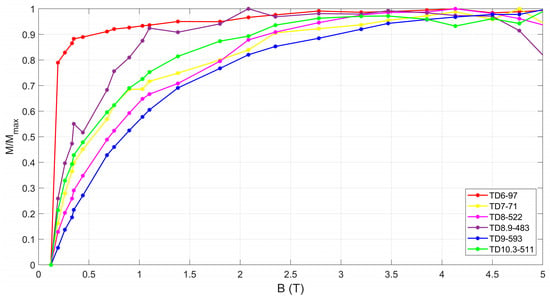
Figure 3.
Progressive acquisition of isothermal remanent magnetization (IRM) up to 5 T of representative samples of each unit.
The different components of the coercivity were analysed using the “Kruiver method” [40], which characterises an assemblage of grains by its SIRM, the median destructive field (B1/2), and the width of the distribution, identified with Dispersion Parameter (DP) (example for TD9 unit in Figure 4). Taking into account the limits of these parameters (explained by [41]), we infer that in the quasi totality of units there are two main components (a third one could be present, but its contribution is minimal because inferior to 5% of the total IRM), except in the TD8.9 unit where three components are clearly distinguished—as shown in Table 3. One feature that deserves to be highlighted is the highest median destructive field found in the second component of a sample taken in the middle-upper part of the TD9 unit (evidenced in light grey in Table 3), which indicates the presence of goethite. As evidenced by previous studies [40,41,42,43,44,45], the discrimination of high coercivity minerals is difficult and depends on their relative percentage on the samples.
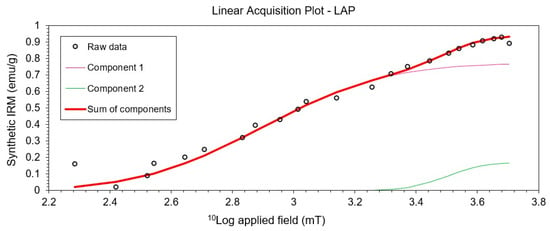
Figure 4.
Analysis of the coercivity components of sample belongs to unit TD9 with the Kruiver approach. IRM acquisition curve and corresponding IRM components on a log-linear scale (LAP) where the circles represent measured data and the solid line the modelled one.

Table 3.
Input parameters (SIRM, B1/2 and DP) of the components individuated for each unit in the Kruiver approach.
To characterize the ferro- and diamagnetic relative contribution, we carried out a number of hysteresis loops (Figure 5). The presence of both para- and ferromagnetism is evident from the shape of the curves. In particular, the loops of samples from units TD9 and TD7 (Figure 5b,e) are a little bit more open than the others, indicating the contribution of high-coercivity minerals such as hematite and goethite [46].
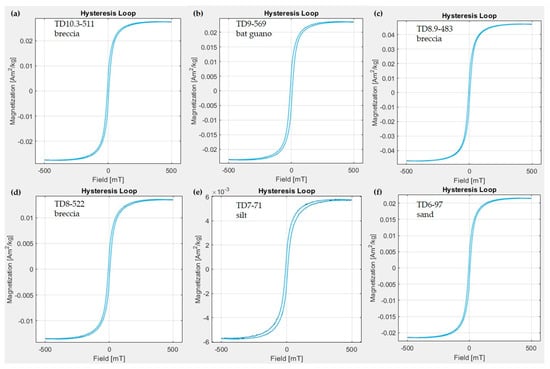
Figure 5.
Magnetic hysteresis loops of representative specimens from different stratigraphic depths, measured with the Magnetometer MicroMag VSM up to a maximum applied field of 500 mT and mass normalized. Curves are corrected for paramagnetic contribution. (a) sample TD10.3–511. (b) sample TD9–569. (c) sample TD8.9–483. (d) sample TD8–522. (e) sample TD7–71. (f) sample TD6–97.
4.2. Concentration Analysis
Low field, bulk magnetic susceptibility is a measure of the concentration of magnetic minerals in the sediments. Low values of K are generally indicative of paramagnetic, antiferromagnetic (hematite), and diamagnetic minerals. Bulk susceptibility (Figure 6a) shows the lowest values in units TD7 and in the upper part of TD9. On the contrary, we see a large ferrimagnetic contribution in the top of TD8.9 and in the subunits of TD10. The phase angle parameter of lower frequency (Figure 6b) presents a slight, yet progressive, increase upward in the profile, only interrupted by minimum values in TD7 and in the middle TD9 units. Finally, the frequency-dependent parameter (Figure 6c) is quite constant with depth but sharply decreases in unit TD9 and lightly in TD7. A possible climatic influence of these changes will be later discussed.
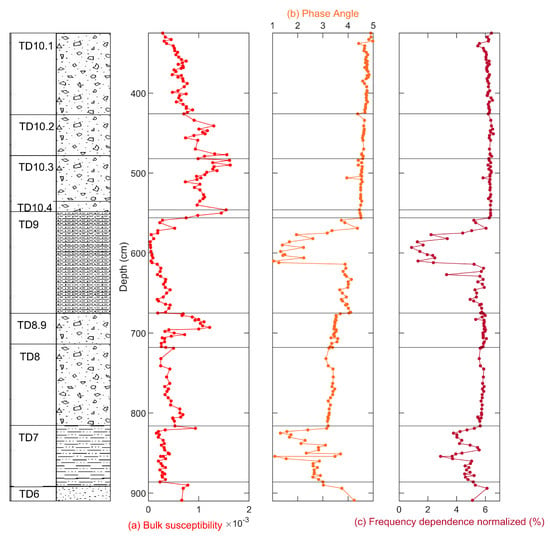
Figure 6.
Magnetic susceptibility parameters, all dimensionless (in SI units), subdivided by units (from TD6 to TD10.1, base to top respectively): (a) Bulk susceptibility; (b) Phase angle parameter; (c) Normalized frequency-dependence parameter. Simplified stratigraphic log to the left.
The intensity of the magnetization is given by (a) the saturation magnetization, (b) the anhysteretic remanence (ARM), and (c) isothermal remanence (IRM) (Figure 7). These parameters evidence the great abundance of low coercivity phase, likely magnetite, in TD10 and in the upper part of the TD8.9 unit. A pronounced maximum of ferrimagnetic material is observed in the boundary between TD10.3 and TD10.2, while the upper subunit presents a slight content decrease. The lower values of magnetization are observed in TD7 and in the middle part of TD9, in particular as revealed by the ARM. The overall pattern confirms again different rockmagnetic features of these units, which will be discussed later.
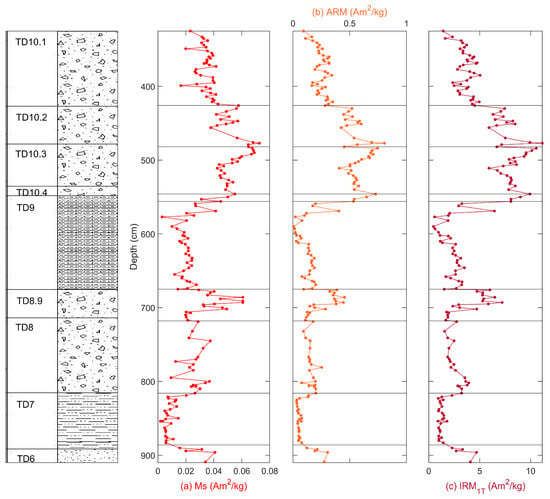
Figure 7.
Remanent magnetization profiles: (a) saturation magnetization (Ms)—taken from the hysteresis loops—(b) anhysteretic remanent magnetization (ARM), (c) isothermal remanent magnetization at 1 T (IRM1T). Simplified stratigraphic log to the left.
Mineralogy composition and grain size can also be evaluated by some additional ratios (Figure 8). The S-ratio (Figure 8a), defined as IRM0.3T/IRM1T, is still the most sensitive parameter for estimating the predominance of antiferromagnetic mineralogy—values near to zero—or ferromagnetic minerals—values near the unity. The entire profile is dominated by magnetite, except in the middle part of the TD9 unit where the presence of a hematite/goethite (high coercivity) mixture is evident. It is important to recall, though, that the presence of high coercivity component could be revealed only if it represents at least 95% of the magnetic fraction, otherwise the magnetite covers it up [47]. The ARM/IRM1T ratio (Figure 8b) presents a decrease in TD7 and in the middle TD9, while it seems quite constant through the rest of the profile. A key ratio for magnetic grain size is the IRM1T/χlf (Figure 8c), as high values correspond to small size particles, whereas low values correspond to large grain size. The profile variations reveal maximum values in the middle part of unit TD9, indicating the minimum particle grain size. We will contrast this distribution with the King plot.
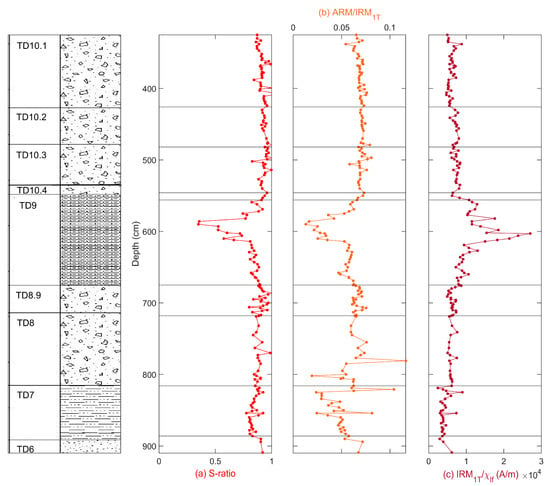
Figure 8.
Characteristic ratios for grain size and mineralogical composition: (a) S-ratio, IRM0.3T/IRM1T; (b) ARM/IRM1T; (c) IRM1T/χlf. Simplified stratigraphic log to the left.
In order to discriminate the relative concentration of each magnetic component, we carried out a particular study based on the contrasting coercivity values and Curie points. We initially produced a saturation magnetization (SIRM) at 5 T followed by alternating field demagnetization at 100 mT to remove the contribution of any “soft” ferrimagnetic minerals (e.g., magnetite). Next, we performed one step of thermal demagnetization at 130 °C to remove the goethite contribution. Therefore, after these two steps, hematite should be the only magnetic mineral contributing to the total magnetization [37]. We plotted the relative contribution of magnetite versus goethite and hematite, called M/GH (Figure 9a), and goethite versus hematite, G/H (Figure 9b), obtained, respectively, by:
and
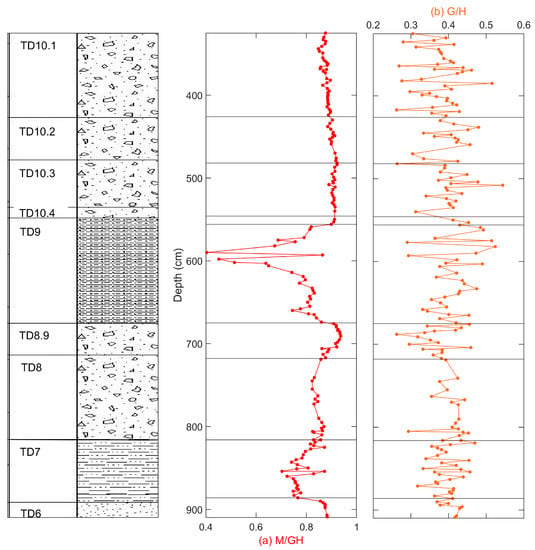
Figure 9.
Magnetic mineral discrimination: (a) concentration of magnetite versus goethite and hematite; (b) concentration of goethite versus hematite. Stratigraphic log on the left.
The M/GH ratio (Figure 9a) shows a slight decrease of the magnetite concentration in TD7 unit. In TD8.9, there is an increase in this mineral, whereas in the middle part of TD9, we find the minimum values of magnetite, as also revealed from previous parameters. Finally, in all subunits of TD10, this content is more or less constant. On the other hand, the G/H ratio variation (Figure 9b) is not conclusive at all. Although, a lower goethite concentration in the TD8.9 unit and a higher abundance in the middle-upper part of TD9 are appreciable.
4.3. Grain Size Analysis
Since the magnetite represents the dominant magnetic mineral in the entire profile, we can consider the Day plot [48] in the modified version proposed by [49] as appropriate in order to analyse the magnetic grain size. We have excluded the samples that do not reach the saturation in hysteresis loops for this analysis, as recommended in [50]. All samples analysed fall in the Pseudo-Single Domain (PSD) field (Figure 10).
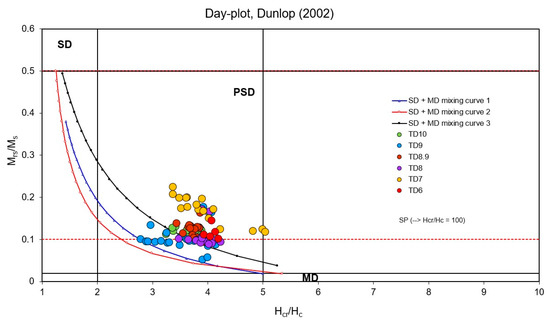
Figure 10.
Day-plot diagram showing the ratios distribution of each stratigraphic unit [49].
To further characterize the grain size variation of the particles, we use the so-called King plot [51] that compares the anhysteretic susceptibility (calculated dividing the ARM for the bias field) and the low-field susceptibility; the slope of the alignment defines the grain size of particles. We distinguish three different grain size groups. The smallest grain size family (light blue in Figure 11) corresponds to the samples from the middle-upper part of TD9, coherently with the interpretation of the IRM1T/χlf profile (Figure 8c). A second group is due to the specimens from unit TD7 (yellow in Figure 11), representing the largest magnetic grain size. Finally, most specimens of the other units show an intermediate size between these two extremes.
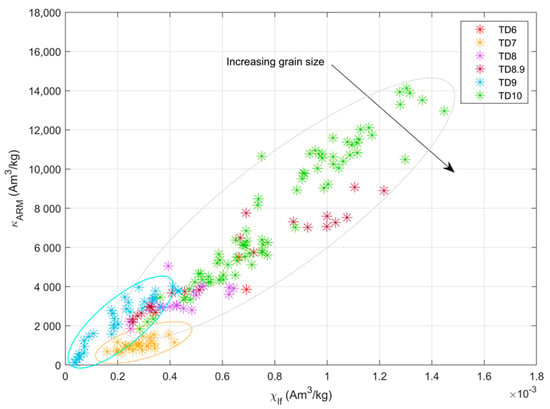
Figure 11.
King plot of the different stratigraphic units. Three different groups of grain size can be distinguished: the smaller grain size, in light blue, is seen in some of the TD9 samples. The largest one, in yellow, is represented by TD7 samples, and, lastly, the most common grain size of all units is found in-between.
5. Discussion
The overall TD4–TD11 stratigraphic record in the cave of Gran Dolina is thought to correspond to open-land, with alternation of wet and dry, habitats [6]; however, palaeoenvironmental studies, based on different proxies, confirm vegetation and faunal changes during the interval of the profile that we have analysed (as summarized in Table 4). The first pollen studies conducted in this cave [4] evidence a passage from temperate climate of the upper subunit of TD6 to a mostly woodland of TD7–TD8 and especially dry and cold conditions in unit TD10. A successive study on non-pollen palynomorphs [5] interprets the TD8 unit as a decay wood environment with high humidity. These proxies document that the TD10 unit reveals variations of moisture in a typical Mediterranean summer context [5]. Taking into account the small vertebrates [6], TD7 is considered a humid and forested stage passing to open-dry environment with sparse forests in TD8.9 and dry-cold condition in TD10. Additionally, the bat remains [52] confirm a climatic deterioration with an aridity increase and cold pulses that started at the TD8.9 unit and was especially strong at the top of TD10. A recent study, based on fish record of Gran Dolina [53], corroborates the presence of a river system characterized by permanent oxygen-rich, relatively cold (ranging from 0 to 20 °C) running waters. From this point of view, the TD5 unit possibly represents the coldest interval in the entire sequence, while the TD10 unit shows a slight decrease in the open-dry habitats and a minor increase in open humid and woodland ones.

Table 4.
Climatic and palaeoenvironmental reconstruction derived by previous studies using different climatic proxies.
Environmental rockmagnetism has largely been studied in the Chinese loess, showing that, in general, higher values of magnetic susceptibility (the so-called “magnetic enhancement”) correspond to warm conditions which would lead to enhancing pedogenesis processes, which, in turn, promote the production of magnetic minerals, and in particular magnetite (e.g., [1] and references therein). Moreover, a recent study proposed the use of paleosol magnetic properties as proxies of paleorainfall and obtained a correspondence between the pedogenic magnetic susceptibility and mean annual precipitation (MAP) values [54].
Taking into account this information on the environmental reconstruction, we pass to interpret our results. Hematite and goethite usually are the result of oxidative weathering and soil formation [55] with some differences: hematite is favoured by higher soil temperatures and lower moisture content, whereas goethite is promoted by moisture and more acid contexts [32]. Furthermore, the water regime is one of the most important influences on the magnetic properties of a soil: in arid conditions, the pedogenic magnetite could not form, while the water logging could dissolve the magnetic minerals [56]. The presence of hematite over goethite suggests environments with low water activity, such as dry or saline soils or sediments [57].
From our study, we infer a relative decrease in magnetite concentration in respect to the high coercivity components in TD7 based on the S-ratio and bulk susceptibility profile (Figure 6a). Based on the conventional wisdom, we could tentatively correlate level TD7 to a warm time interval. The results of the TD8 unit suggest a distinct magnetite content and a constant high coercivity concentration; moreover, the presence of a stalagmitic crust on the top suggests a warm to temperate climate [17], and it was tentatively attributed to MIS13 (Marine Isotope Stage; [58]). The higher concentration of magnetite and the slight decrease of high coercivity content found in TD8.9 unit can be considered a passage from a humid and cold period. Higher up in the section, the middle-upper part of TD9 unit stands out both because of its visible stratigraphic characteristics (Figure 12) and for its distinctive rockmagnetic properties as shown in this study. As far as stratigraphy, the upper part of TD9 constitutes a rather thick unit of finer grain sediments, in contrast to the underlying and overlying units made up by coarse breccias. Additionally, the lamination and the colour changes configure this level as a distinctive interval in the whole section.
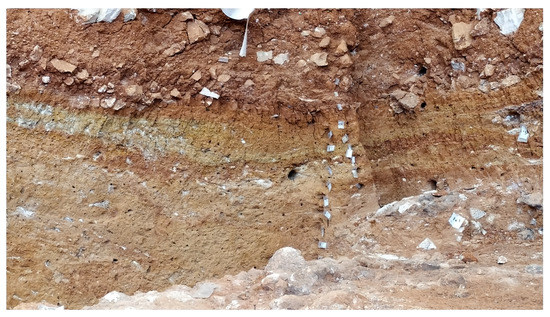
Figure 12.
Detailed view of the TD9 unit and contact with TD10 (overlying breccias), showing the characteristic alternating colours and parallel lamination.
Resuming the results, the middle-upper part of TD9 unit presents the following: low magnetic susceptibility (Figure 6a) compared to the entire sequence; a decrease of the superparamagnetic contribution (as evidenced by frequency-dependent susceptibility in Figure 6c); and especially an abundance of hard ferromagnetic minerals (goethite and hematite) as shown by lower values of S-ratio (Figure 8a) and by IRM progressive acquisition curve (light blue in Figure 3), far from saturation. Moreover, such level presents the smallest magnetic particles of the entire profile, as detected by maximum values of IRM1T/χlf (Figure 8c) and by the King plot (Figure 11). Previous studies also conducted also cave environments [59,60,61] reveal that the increase in susceptibility, correlated to the presence of magnetite, could be due to warm climatic periods, possibly for the pedogenesis processes mentioned earlier. Therefore, the decrease of susceptibility observed in this middle-upper part of the TD9 unit could suggest a priori, the opposite, a cold interval inhibiting the formation and/or deposition of magnetite.
An additional prominent feature distinguishes the TD9 unit, namely the presence of goethite as inferred from the coercivity study that shows extreme values of B1/2 (more than 3000 mT, as summarized in Table 3). The presence of goethite could cover up the SP particles present in this level and could indicate a rather humid environment for the conditions necessary to form this mineral.
The age dating results could help our proposed environmental reconstruction. There exist a number of age data for the upper levels of the Gran Dolina cave. In particular, a first study [13] using ESR and U-series on teeth assigns to TD8 a mean age of 602 ± 52 ka and 372 ± 33 ka for TD10. For this last, the authors suggested a rapid sedimentation rate and a possible correlation to MIS11. Based on thermoluminescence (TL) and infrared-stimulated-luminescence (IRSL) methods [28], subsequent ages were obtained: 960 ± 120 ka for TD7; 820 ± 140 ka for TD8; 480 ± 130 ka for TD9; and a time interval between 430 ± 59 and 240 ± 44 ka for TD10, although, later on, [62] discussed the validity of such TL results and furnished new ages based on thermally transferred optically stimulated-luminescence (TT-OSL), namely 856 ± 75 ka for TD6, which is in excellent agreement with new paleomagnetic data [14]. In [63], a new age of 418 ± 113 ka was added for the TD9 unit. Finally, ESR data on optically bleached quartz grains extracted from sediments (ESR-OB, [29]) furnished new values. All of these results are reported in Table 5.

Table 5.
Datation of upper sedimentary infill of the Gran Dolina cave obtained by different methods.
The bulk of these numerical ages should be taken into account when attempting to correlate the stratigraphic units to the corresponding Marine Isotope Stage (MIS) scale. A recently published study [64] furnishes ages of 425 ka and 360 ka to MIS11, which is in agreement with the attribution of the TD10 unit to this stage (as suggested by [17]). MIS11 is defined as a period of reduced global ice volume with numerous interstadial-stadial events [65] and composed of five substages: the 11a, 11c, and 11e relatively warm intervals and the relatively cold MIS11b and 11d [64]. Such alternating warm–cold intervals make it possible that the middle-upper part of TD9, which we think represents a cold interval with high moisture conditions with the concomitant goethite relative abundance, corresponds to MIS11.
6. Conclusions
The rock-magnetism analysis allows us to discern three different magnetic components present in the cave sediments in the upper infill of Gran Dolina, namely units TD7 to TD10: magnetite, goethite, and hematite. The relative concentration variations along the profile are thought to reflect climatic changes during the sediment deposition in the cave. In particular, we suggest a shift from warm to cold climatic conditions from units TD6 to TD7, characterised by a decrease in magnetic susceptibility, a lower concentration of magnetite including SP particles. A similar pattern is observed in the middle-upper part of unit TD9, where we noticed among the lowest values of bulk susceptibility—decrease of magnetite—and the presence of goethite. These observations suggest a cold environment with relatively high moisture in order to account for the production of high coercivity component. Last, we tentatively assign units TD9 and TD10 to the MIS11 stage (also suggested in [13,23,24,25]), which agrees with previous interpretation of the stratigraphic record [27,53]. Ongoing research on both chronology and rockmagnetism will help further interpret the fossiliferous and archaeological units in terms of the climatic shifts during the Quaternary.
Author Contributions
Conceptualization, methodology, software, S.D., J.M.P. and F.M.-H.; validation, J.M.P. and F.M.-H.; formal analysis, investigation, S.D.; resources, data curation, J.M.P. and F.M.-H.; writing—original draft preparation, S.D.; writing—review and editing, S.D., J.M.P. and F.M.-H.; visualization, supervision, J.M.P. and F.M.-H.; project administration, funding acquisition, J.M.P. All authors have read and agreed to the published version of the manuscript.
Funding
This research was funded by Spanish Grant PID2021-122355NB-C33 and PID2021-123092NB-C22, financed by MCIN/AEI/10.13039/501100011033/FEDER, UE.
Institutional Review Board Statement
Not applicable.
Informed Consent Statement
Not applicable.
Data Availability Statement
Not applicable.
Acknowledgments
We would like to thank the Fundación Atapuerca and the Junta de Castilla y León for continuous support to the research in the Atapuerca archaeological sites. A personal acknowledgement to the researchers Marina Mosquera, Andreu Ollé, and Palmira Saladié (IPHES), for making possible sampling in this part of Gran Dolina and their patience during field work. Constructive comments by two anonymous reviewers are gratefully acknowledged.
Conflicts of Interest
The authors declare no conflict of interest. The funders had no role in the design of the study; in the collection, analyses, or interpretation of data; in the writing of the manuscript; or in the decision to publish the results.
References
- Evans, M.E.; Heller, F. Environmental Magnetism: Principles and Applications of Enviromagnetics; International Geophysics Series; Elsevier Science: Alpharetta, GA, USA, 2003; Volume 86. [Google Scholar]
- Liu, Q.; Roberts, A.P.; Larrasoaña, J.C.; Banerjee, S.K.; Guyodo, Y.; Tauxe, L.; Oldfield, F. Environmental magnetism: Principles and applications. Rev. Geophys. 2012, 50, 393. [Google Scholar] [CrossRef]
- Thompson, R.; Oldfield, F. Environmental Magnetism; Allen & Unwin Ltd.: London, UK, 1986. [Google Scholar] [CrossRef]
- García-Antón, M. Paleovegetación del Pleistoceno Medio de Atapuerca a través del análisis polínico. In Evolución Humana en Europa y los Yacimientos de la Sierra de Atapuerca; Bermúdez de Castro, J.M., Arsuaga, J.L., Carbonell, E., Eds.; Junta de Castilla y León: Valladolid, Spain, 1995; pp. 147–165. [Google Scholar]
- Expósito, I.; Burjachs, F.; Allué, E. Filling in the gaps: The contribution of non-pollen palynomorphs to knowledge about the local environment of the Sierra de Atapuerca caves during the Pleistocene. Quat. Int. 2017, 433, 224–242. [Google Scholar] [CrossRef]
- Cuenca-Bescós, G.; Melero-Rubio, M.; Rofes, J.; Martínez, I.; Arsuaga, J.; Blain, H.-A.; López-García, J.; Carbonell, E.; De Castro, J.B. The Early–Middle Pleistocene environmental and climatic change and the human expansion in Western Europe: A case study with small vertebrates (Gran Dolina, Atapuerca, Spain). J. Hum. Evol. 2011, 60, 481–491. [Google Scholar] [CrossRef] [PubMed]
- D’Arcangelo, S.; Martín-Hernández, F.; Parés, J.M. Magnetic properties of cave sediments at Gran Dolina site in Sierra de Atapuerca (Burgos, Spain). Quat. Int. 2021, 583, 1–13. [Google Scholar] [CrossRef]
- Ortega, A.; Benito-Calvo, A.; Pérez-González, A.; Martín-Merino, M.; Pérez-Martínez, R.; Parés, J.; Aramburu, A.; Arsuaga, J.; de Castro, J.B.; Carbonell, E. Evolution of multilevel caves in the Sierra de Atapuerca (Burgos, Spain) and its relation to human occupation. Geomorphology 2013, 196, 122–137. [Google Scholar] [CrossRef]
- Gil, E.; Aguirre, E.; Hoyos, M. Contexto estratigráfico. In El Hombre Fósil de Ibeas y El Pleistoceno de la Sierra de Atapuerca; Aguirre, E., Carbonell, E., Bermúdez de Castro, J.M., Eds.; Junta de Castilla y León, Consejería de Cultura y Bienestar Social: Valladolid, Spain, 1987; pp. 47–54. [Google Scholar]
- Parés, J.; Pérez-González, A. Magnetochronology and stratigraphy at Gran Dolina section, Atapuerca (Burgos, Spain). J. Hum. Evol. 1999, 37, 325–342. [Google Scholar] [CrossRef] [PubMed]
- Duval, M.; Arnold, L.J.; Demuro, M.; Parés, J.M.; Campaña, I.; Carbonell, E.; de Castro, J.M.B. New chronological constraints for the lowermost stratigraphic unit of Atapuerca Gran Dolina (Burgos, N Spain). Quat. Geochronol. 2022, 71, 101292. [Google Scholar] [CrossRef]
- Campaña, I.; Benito-Calvo, A.; Pérez-González, A.; Ortega, A.; de Castro, J.B.; Carbonell, E. Pleistocene sedimentary facies of the Gran Dolina archaeo-paleoanthropological site (Sierra de Atapuerca, Burgos, Spain). Quat. Int. 2017, 433, 68–84. [Google Scholar] [CrossRef]
- Campaña, I.; Pérez-González, A.; Benito-Calvo, A.; Rosell, J.; Blasco, R.; de Castro, J.M.B.; Carbonell, E.; Arsuaga, J.L. New interpretation of the Gran Dolina-TD6 bearing Homo antecessor deposits through sedimentological analysis. Sci. Rep. 2016, 6, 34799. [Google Scholar] [CrossRef]
- Parés, J.M.; Ortega, A.I.; Benito-Calvo, A.; Aranburu, A.; Arsuaga, J.L.; Bermúdez de Castro, J.M.; Carbonell, E. Paleomagnetic constraints on the Atapuerca karst development (N Spain). In Caves and Karst Across Time; Feinberg, J., Gao, Y., Alexander, E.C., Jr., Eds.; The Geological Society of America: Boulder, CO, USA, 2016; Volume 516, pp. 285–300. [Google Scholar] [CrossRef]
- Álvarez-Posada, C.; Parés, J.M.; Cuenca-Bescós, G.; Van der Made, J.; Rosell, J.; de Castro, J.M.B.; Carbonell, E. A post-Jaramillo age for the artefact-bearing layer TD4 (Gran Dolina, Atapuerca): New paleomagnetic evidence. Quat. Geochronol. 2018, 45, 1–8. [Google Scholar] [CrossRef]
- Mallol, C.; i Roura, E.C. The Collapse of Gran Dolina cave, Sierra de Atapuerca, Spain: Site formation processes of layer TD10-1. Geoarchaeology 2008, 23, 13–41. [Google Scholar] [CrossRef]
- Falguères, C.; Bahain, J.-J.; Yokoyama, Y.; Arsuaga, J.L.; de Castro, J.M.B.; Carbonell, E.; Bischoff, J.L.; Dolo, J.-M. Earliest humans in Europe: The age of TD6 Gran Dolina, Atapuerca, Spain. J. Hum. Evol. 1999, 37, 343–352. [Google Scholar] [CrossRef]
- Parés, J.; Arnold, L.; Duval, M.; Demuro, M.; Pérez-González, A.; de Castro, J.B.; Carbonell, E.; Arsuaga, J. Reassessing the age of Atapuerca-TD6 (Spain): New paleomagnetic results. J. Archaeol. Sci. 2013, 40, 4586–4595. [Google Scholar] [CrossRef]
- Moreno, D.; Falguères, C.; Pérez-González, A.; Duval, M.; Voinchet, P.; Benito-Calvo, A.; Ortega, A.I.; Bahain, J.-J.; Sala, R.; Carbonell, E.; et al. ESR chronology of alluvial deposits in the Arlanzón valley (Atapuerca, Spain): Contemporaneity with Atapuerca Gran Dolina site. Quat. Geochronol. 2012, 10, 418–423. [Google Scholar] [CrossRef]
- Duval, M.; Grün, R.; Parés, J.M.; Martín-Francés, L.; Campaña, I.; Rosell, J.; Shao, Q.; Arsuaga, J.L.; Carbonell, E.; de Castro, J.M.B. The first direct ESR dating of a hominin tooth from Atapuerca Gran Dolina TD-6 (Spain) supports the antiquity of Homo antecessor. Quat. Geochronol. 2018, 47, 120–137. [Google Scholar] [CrossRef]
- Carbonell, E.; de Castro, J.M.B.; Arsuaga, J.L.; Díez, J.C.; Rosas, A.; Cuenca-Bescós, G.; Sala, R.; Mosquera, M.; Rodriguez, X.P. Lower Pleistocene Hominids and Artifacts from Atapuerca-TD6 (Spain). Science 1995, 269, 826–829. [Google Scholar] [CrossRef] [PubMed]
- Blain, H.-A.; Bailon, S.; Cuenca-Bescós, G. The Early–Middle Pleistocene palaeoenvironmental change based on the squamate reptile and amphibian proxies at the Gran Dolina site, Atapuerca, Spain. Palaeogeogr. Palaeoclim. Palaeoecol. 2008, 261, 177–192. [Google Scholar] [CrossRef]
- Blain, H.-A.; Bailon, S.; Cuenca-Bescós, G.; Arsuaga, J.L.; de Castro, J.M.B.; Carbonell, E. Long-term climate record inferred from early-middle Pleistocene amphibian and squamate reptile assemblages at the Gran Dolina Cave, Atapuerca, Spain. J. Hum. Evol. 2009, 56, 55–65. [Google Scholar] [CrossRef] [PubMed]
- Blain, H.-A.; Cuenca-Bescós, G.; Burjachs, F.; López-García, J.M.; Lozano-Fernández, I.; Rosell, J. Early Pleistocene palaeoenvironments at the time of the Homo antecessor settlement in the Gran Dolina cave (Atapuerca, Spain). J. Quat. Sci. 2013, 28, 311–319. [Google Scholar] [CrossRef]
- Blain, H.-A.; Fagoaga, A.; Ruiz-Sánchez, F.J.; García-Medrano, P.; Ollé, A.; Jiménez-Arenas, J.M. Coping with arid environments: A critical threshold for human expansion in Europe at the Marine Isotope Stage 12/11 transition? The case of the Iberian Peninsula. J. Hum. Evol. 2021, 153, 102950. [Google Scholar] [CrossRef]
- Rodríguez, J.; Burjachs, F.; Cuenca-Bescós, G.; García, N.; van der Made, J.; Pérez-González, A.; Blain, H.-A.; Expósito, I.; López-García, J.M.; García Antón, M.; et al. One million years of cultural evolution in a stable environmental at Atapuerca (Burgos, Spain). Quat. Sci. Rev. 2011, 30, 1396–1412. [Google Scholar] [CrossRef]
- Falgéres, C.; Bahain, J.-J.; Yokoyama, Y.; Bischoff, J.L.; Arsuaga, J.L.; de Castro, J.M.B.; Carbonell, E.; Dolo, J.-M. Datation par RPE et U-TH des sites pléistocénes d’Atapuerca: Sima de los Huesos, Trinchera Dolina et Trinchera Galería. bilan géochronologique. L’anthropologie 2001, 105, 71–81. [Google Scholar] [CrossRef]
- Berger, G.; Pérez-González, A.; Carbonell, E.; Arsuaga, J.; de Castro, J.-M.B.; Ku, T.-L. Luminescence chronology of cave sediments at the Atapuerca paleoanthropological site, Spain. J. Hum. Evol. 2008, 55, 300–311. [Google Scholar] [CrossRef] [PubMed]
- Moreno, D.; Falguères, C.; Pérez-González, A.; Voinchet, P.; Ghaleb, B.; Despriée, J.; Bahain, J.-J.; Sala, R.; Carbonell, E.; de Castro, J.M.B.; et al. New radiometric dates on the lowest stratigraphical section (TD1 to TD6) of Gran Dolina site (Atapuerca, Spain). Quat. Geochronol. 2015, 30, 535–540. [Google Scholar] [CrossRef]
- Rosell, J.; Blasco, R.; Campeny, G.; Díez, J.; Alcalde, R.A.; Menéndez, L.; Arsuaga, J.L.; de Castro, J.M.B.; Carbonell, E. Bone as a technological raw material at the Gran Dolina site (Sierra de Atapuerca, Burgos, Spain). J. Hum. Evol. 2011, 61, 125–131. [Google Scholar] [CrossRef] [PubMed]
- Rodríguez-Hidalgo, A.; Saladié, P.; Ollé, A.; Arsuaga, J.L.; de Castro, J.M.B.; Carbonell, E. Human predatory behavior and the social implications of communal hunting based on evidence from the TD10.2 bison bone bed at Gran Dolina (Atapuerca, Spain). J. Hum. Evol. 2017, 105, 89–122. [Google Scholar] [CrossRef]
- Maher, B.; Karloukovski, V.; Mutch, T. High-field remanence properties of synthetic and natural submicrometre haematites and goethites: Significance for environmental contexts. Earth Planet. Sci. Lett. 2004, 226, 491–505. [Google Scholar] [CrossRef]
- Néel, L. Théorie du traînage magnétique des ferromagnétiques en grains fins avec applications aux terres cuites. Ann. Geophys. 1949, 5, 99–136. [Google Scholar]
- Egli, R. Magnetic susceptibility measurements as a function of temperature and frequency I: Inversion theory. Geophys. J. Int. 2009, 177, 395–420. [Google Scholar] [CrossRef]
- Hrouda, F. Models of frequency-dependent susceptibility of rocks and soils revisited and broadened. Geophys. J. Int. 2011, 187, 1259–1269. [Google Scholar] [CrossRef]
- Dearing, J.A.; Dann, R.J.L.; Hay, K.; Lees, J.A.; Loveland, P.J.; Maher, B.; O’Grady, K. Frequency-dependent susceptibility measurements of environmental materials. Geophys. J. Int. 1996, 124, 228–240. [Google Scholar] [CrossRef]
- Kodama, K.P.; Hinnov, L.A. Rock Magnetism. In Rock Magnetic Cyclostratigraphy; Kodama, K.P., Hinnov, L.A., Eds.; John Wiley & Sons: Hoboken, NJ, USA, 2014. [Google Scholar] [CrossRef]
- Font, E.; Veiga-Pires, C.; Pozo, M.; Carvallo, C.; de Siqueira Neto, A.C.; Camps, P.; Fabre, S.; Mirao, J. Magnetic fingerprint of southern Portuguese speleothems and implications for paleomagnetism and environmental magnetism. J. Geophys. Res. Solid Earth 2014, 119, 7993–8020. [Google Scholar] [CrossRef]
- Carrancho, Á.; Villalain, J.J.; Angelucci, D.E.; Dekkers, M.J.; Vallverdú, J.; Vergès, J.M. Rock-magnetic analyses as a tool to investigate archaeological fired sediments: A case study of Mirador cave (Sierra de Atapuerca, Spain). Geophys. J. Int. 2009, 179, 79–96. [Google Scholar] [CrossRef]
- Kruiver, P.P.; Dekkers, M.J.; Heslop, D. Quantification of magnetic coercivity components by the analysis of acquisition curves of isothermal remanent magnetization. Earth Planet Sci. Lett. 2001, 189, 269–276. [Google Scholar] [CrossRef]
- Egli, R. Analysis of the field dependence of remanent magnetization curves. J. Geophys. Res. Atmos. 2003, 108, 2081. [Google Scholar] [CrossRef]
- Dankers, P. Relationship between median destructive field and remanent coercive forces for dispersed natural magnetite, titanomagnetite and hematite. Geophys. J. Int. 1981, 64, 447–461. [Google Scholar] [CrossRef]
- Chaparro, M.A.E.; Sinito, A.M.; Bidegain, J.C.; de Barrio, R.E. Magnetic studies of natural goethite samples from Tharsis, Huelva, Spain. Geofísica Int. 2006, 45, 219–230. [Google Scholar] [CrossRef]
- Özdemir, Ö.; Dunlop, D.J. Hysteresis and coercivity of hematite. J. Geophys. Res. Solid Earth 2014, 119, 2582–2594. [Google Scholar] [CrossRef]
- Ahmadzadeh, M.; Romero, C.; McCloy, J. Magnetic analysis of commercial hematite, magnetite, and their mixtures. AIP Adv. 2018, 8, 056807. [Google Scholar] [CrossRef]
- Roberts, A.P.; Cui, Y.; Verosub, K.L. Wasp-waisted hysteresis loops: Mineral magnetic characteristics and discrimination of components in mixed magnetic systems. J. Geophys. Res. Solid Earth 1995, 100, 17909–17924. [Google Scholar] [CrossRef]
- Frank, U.; Nowaczyk, N.R. Mineral magnetic properties of artificial samples systematically mixed from haematite and magnetite. Geophys. J. Int. 2008, 175, 449–461. [Google Scholar] [CrossRef]
- Day, R.; Fuller, M.; Schmidt, V.A. Hysteresis properties of titanomagnetites: Grain-size and compositional dependence. Phys. Earth Planet. Inter. 1977, 13, 260–267. [Google Scholar] [CrossRef]
- Dunlop, D.J. Theory and application of the Day plot (Mrs/Ms versus Hcr/Hc) 1. Theoretical curves and tests using titanomagnetite data. J. Geophys. Res. Atmos. 2002, 107, 486. [Google Scholar] [CrossRef]
- Roberts, A.P.; Hu, P.; Harrison, R.J.; Heslop, D.; Muxworthy, A.R.; Oda, H.; Sato, T.; Tauxe, L.; Zhao, X. Domain State Diagnosis in Rock Magnetism: Evaluation of Potential Alternatives to the Day Diagram. J. Geophys. Res. Solid Earth 2019, 124, 5286–5314. [Google Scholar] [CrossRef]
- King, J.; Banerjee, S.K.; Marvin, J.; Özdemir, Ö. A comparison of different magnetic methods for determining the relative grain size of magnetite in natural materials: Some results from lake sediments. Earth Planet. Sci. Lett. 1982, 59, 404–419. [Google Scholar] [CrossRef]
- Galán, J.; Núñez-Lahuerta, C.; Moya-Costa, R.; López-García, J.M.; Cuenca-Bescós, G. Fossil bat assemblages as palaeoenvironmental and palaeoclimatic indicators: A case study in the Lower to Middle Pleistocene Gran Dolina sequence of Sierra de Atapuerca, Northern Spain. Palaeogeogr. Palaeoclim. Palaeoecol. 2019, 535, 109365. [Google Scholar] [CrossRef]
- Blanco-Lapaz, A.; Martínez-Monzón, A.; Blain, H.-A.; Cuenca-Bescós, G. Early-Middle Pleistocene freshwater ecosystems in the Sierra de Atapuerca (northern Iberia) based on the Gran Dolina fish record. Palaeogeogr. Palaeoclim. Palaeoecol. 2021, 574, 110444. [Google Scholar] [CrossRef]
- Maher, B.; Possolo, A. Statistical models for use of palaeosol magnetic properties as proxies of palaeorainfall. Glob. Planet. Chang. 2013, 111, 280–287. [Google Scholar] [CrossRef]
- Maher, B. Characterisation of soils by mineral magnetic measurements. Phys. Earth Planet. Inter. 1986, 42, 76–92. [Google Scholar] [CrossRef]
- Hanesch, M.; Scholger, R. The influence of soil type on the magnetic susceptibility measured throughout soil profiles. Geophys. J. Int. 2005, 161, 50–56. [Google Scholar] [CrossRef]
- Torrent, J.; Guzman, R. Crystallization of Fe(III)-Oxides from ferrihydrite in salt solutions: Osmotic and specific ion effects. Clay Miner. 1982, 17, 463–469. [Google Scholar] [CrossRef]
- Antoñanzas, R.L.; Bescós, G.C. The Gran Dolina site (Lower to Middle Pleistocene, Atapuerca, Burgos, Spain): New palaeoenvironmental data based on the distribution of small mammals. Palaeogeogr. Palaeoclim. Palaeoecol. 2002, 186, 311–334. [Google Scholar] [CrossRef]
- Ellwood, B.B.; Petruso, K.M.; Harrold, F.B.; Korkuti, M. Paleoclimate Characterization and Intra-Site Correlation Using Magnetic Susceptibility Measurements: An Example from Konispol Cave, Albania. J. Field Archaeol. 1996, 23, 263–271. [Google Scholar] [CrossRef]
- Ellwood, B.B.; Zilhão, J.; Harrold, F.B.; Balsam, W.; Burkart, B.; Long, G.J.; Debénath, A.; Bouzouggar, A. Identification of the last glacial maximum in the upper Palolithic of Portugal using magnetic susceptibility measurements of Caldeirão cave sediments. Geoarchaeology 1998, 13, 55–71. [Google Scholar] [CrossRef]
- Sroubek, P.; Diehl, J.F.; Kadlec, J.; Valoch, K. A Late Pleistocene palaeoclimate record based on mineral magnetic properties of the entrance facies sediments of Kulna Cave, Czech Republic. Geophys. J. Int. 2001, 147, 247–262. [Google Scholar] [CrossRef]
- Arnold, L.J.; Demuro, M.; Parés, J.M.; Pérez-González, A.; Arsuaga, J.L.; de Castro, J.M.B.; Carbonell, E. Evaluating the suitability of extended-range luminescence dating techniques over early and Middle Pleistocene timescales: Published datasets and case studies from Atapuerca, Spain. Quat. Int. 2015, 389, 167–190. [Google Scholar] [CrossRef]
- Falguères, C.; Bahain, J.-J.; Bischoff, J.L.; Pérez-González, A.; Ortega, A.I.; Ollé, A.; Quiles, A.; Ghaleb, B.; Moreno, D.; Dolo, J.-M.; et al. Combined ESR/U-series chronology of Acheulian hominid-bearing layers at Trinchera Galería site, Atapuerca, Spain. J. Hum. Evol. 2013, 65, 168–184. [Google Scholar] [CrossRef]
- Wang, Y.; Yang, X.; Wang, Y.; Wang, Q.; Edwards, R.L. The structure of marine isotope Stage 11 and its alignment with the Holocene. Palaeogeogr. Palaeoclim. Palaeoecol. 2023, 609, 111311. [Google Scholar] [CrossRef]
- Candy, I.; Schreve, D.C.; Sherriff, J.; Tye, G.J. Marine Isotope Stage 11: Palaeoclimates, palaeoenvironments and its role as an analogue for the current interglacial. Earth-Sci. Rev. 2014, 128, 18–51. [Google Scholar] [CrossRef]
Disclaimer/Publisher’s Note: The statements, opinions and data contained in all publications are solely those of the individual author(s) and contributor(s) and not of MDPI and/or the editor(s). MDPI and/or the editor(s) disclaim responsibility for any injury to people or property resulting from any ideas, methods, instructions or products referred to in the content. |
© 2023 by the authors. Licensee MDPI, Basel, Switzerland. This article is an open access article distributed under the terms and conditions of the Creative Commons Attribution (CC BY) license (https://creativecommons.org/licenses/by/4.0/).